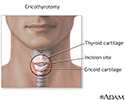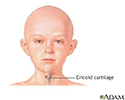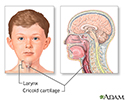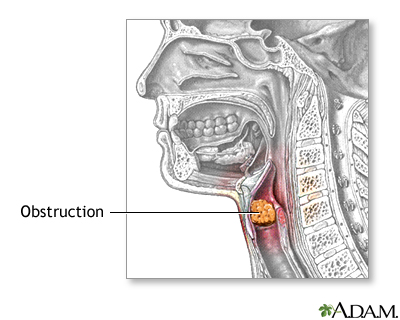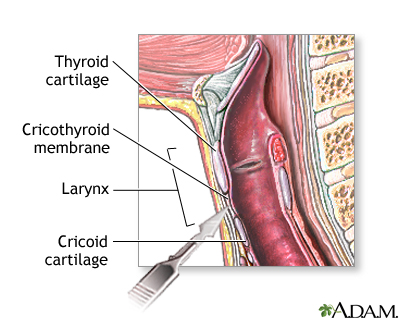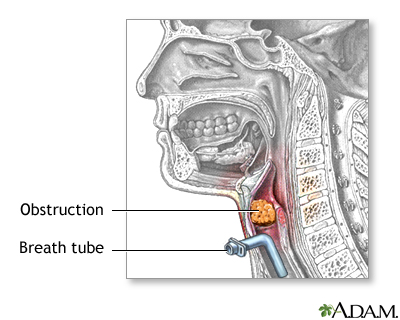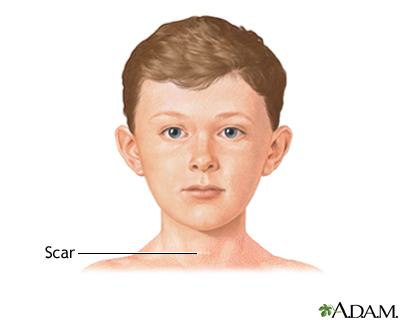Emergency airway puncture
Needle cricothyrotomy
Emergency airway puncture is the placement of a hollow needle through the throat into the airway. It is done to treat life-threatening choking.
Description
Emergency airway puncture is done in an emergency situation, when someone is choking and all other efforts to assist with breathing have failed.
Choking
Choking is when someone is having a very hard time breathing because food, a toy, or other object is blocking the throat or windpipe (airway). A cho...

- A hollow needle or tube can be inserted into the throat, just below the Adam's apple (cricoid cartilage), into the airway.
- In a hospital, a small cut in the skin is made before inserting the needle.
Why the Procedure Is Performed
A cricothyrotomy is an emergency procedure to relieve an airway obstruction until surgery can be done to place a breathing tube ( tracheostomy ).
Airway obstruction
Breathing difficulty may involve:Difficult breathingUncomfortable breathingFeeling like you are not getting enough air

Tracheostomy
A tracheostomy is a surgical procedure to create an opening through the neck into the trachea (windpipe). A tube is usually placed through this open...

If the airway blockage occurs with trauma to the head, neck, or spine, care must be taken to avoid further injury to the person.
Risks
Risks for this procedure include:
- Injury to the voice box (larynx), thyroid gland, or esophagus
Risks for any surgery are:
- Bleeding
- Infection
Outlook (Prognosis)
How well the person does depends on the cause of the airway blockage and how quickly the person receives proper breathing support. Emergency airway puncture provides enough breathing support for only a very short period of time.
References
Hebert RB, Bose S, Mace SE. Cricothyrotomy and percutaneous translaryngeal ventilation. In: Roberts JR, ed. Roberts and Hedges's Clinical Procedures in Emergency Medicine . 6th ed. Philadelphia, PA: Elsevier Saunders; 2014:chap 6.
Thomas SH, Goodloe JM. Foreign bodies. In: Marx J, Hockberger RS, Walls RM, et al, eds. Rosen's Emergency Medicine: Concepts and Clinical Practice . 8th ed. Philadelphia, PA: Elsevier Saunders; 2014:chap 60.
-
Emergency airway puncture - illustration
An emergency airway puncture may be performed if all efforts to dislodge an object from the throat have failed. The procedure involves inserting a hollow needle into the throat just below the thyroid cartilage and should only be performed by a medical professional.
Emergency airway puncture
illustration
-
Cricoid cartilage - illustration
The cricothyroid membrane, the softer area between the firmer and more prominent thyroid cartilage (Adam’s apple) and the smaller cricoid cartilage, is the portion of the throat used to insert a hollow needle to assist in breathing when other attempts have failed. This procedure is also known as an emergency airway puncture or cricothyrotomy.
Cricoid cartilage
illustration
-
Emergency airway puncture - series
Presentation
-
Emergency airway puncture - illustration
An emergency airway puncture may be performed if all efforts to dislodge an object from the throat have failed. The procedure involves inserting a hollow needle into the throat just below the thyroid cartilage and should only be performed by a medical professional.
Emergency airway puncture
illustration
-
Cricoid cartilage - illustration
The cricothyroid membrane, the softer area between the firmer and more prominent thyroid cartilage (Adam’s apple) and the smaller cricoid cartilage, is the portion of the throat used to insert a hollow needle to assist in breathing when other attempts have failed. This procedure is also known as an emergency airway puncture or cricothyrotomy.
Cricoid cartilage
illustration
-
Emergency airway puncture - series
Presentation
Review Date: 11/28/2016
Reviewed By: Jacob L. Heller, MD, MHA, Emergency Medicine, Virginia Mason Medical Center, Seattle, WA. Also reviewed by David Zieve, MD, MHA, Medical Director, Brenda Conaway, Editorial Director, and the A.D.A.M. Editorial team.

